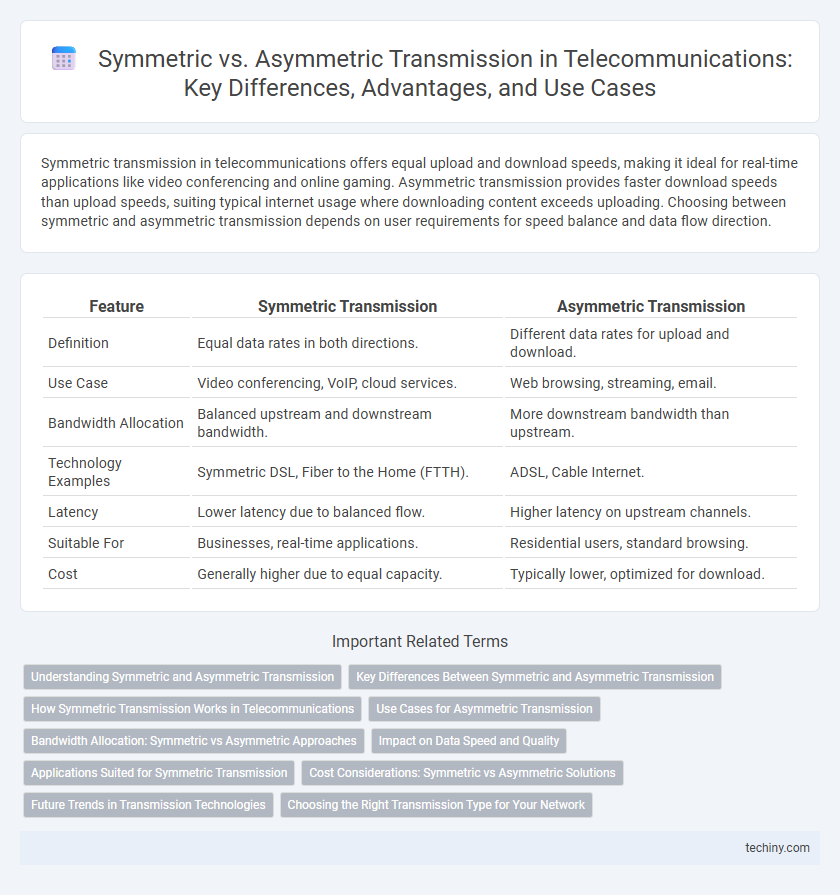Symmetric transmission in telecommunications offers equal upload and download speeds, making it ideal for real-time applications like video conferencing and online gaming. Asymmetric transmission provides faster download speeds than upload speeds, suiting typical internet usage where downloading content exceeds uploading. Choosing between symmetric and asymmetric transmission depends on user requirements for speed balance and data flow direction.
Table of Comparison
| Feature | Symmetric Transmission | Asymmetric Transmission |
|---|---|---|
| Definition | Equal data rates in both directions. | Different data rates for upload and download. |
| Use Case | Video conferencing, VoIP, cloud services. | Web browsing, streaming, email. |
| Bandwidth Allocation | Balanced upstream and downstream bandwidth. | More downstream bandwidth than upstream. |
| Technology Examples | Symmetric DSL, Fiber to the Home (FTTH). | ADSL, Cable Internet. |
| Latency | Lower latency due to balanced flow. | Higher latency on upstream channels. |
| Suitable For | Businesses, real-time applications. | Residential users, standard browsing. |
| Cost | Generally higher due to equal capacity. | Typically lower, optimized for download. |
Understanding Symmetric and Asymmetric Transmission
Symmetric transmission in telecommunications ensures equal data rates for both upstream and downstream channels, commonly used in applications requiring balanced communication like video conferencing. Asymmetric transmission provides different data rates, typically higher downstream speeds compared to upstream, optimizing resources for activities such as streaming and web browsing where download demand exceeds upload. Understanding these transmission types is crucial for network design and service selection based on specific bandwidth needs and user behavior patterns.
Key Differences Between Symmetric and Asymmetric Transmission
Symmetric transmission provides equal bandwidth for both upstream and downstream data, enhancing performance in applications requiring balanced data flow such as video conferencing and online gaming. Asymmetric transmission offers higher download speeds compared to upload speeds, optimizing bandwidth usage for typical internet activities like web browsing and streaming. The choice between symmetric and asymmetric transmission significantly impacts network efficiency, cost, and user experience depending on the specific telecommunications needs.
How Symmetric Transmission Works in Telecommunications
Symmetric transmission in telecommunications involves equal data transfer rates in both directions between two devices, enabling simultaneous send and receive operations. This method uses paired communication channels or duplex systems to maintain balanced bandwidth, which enhances real-time applications like video conferencing and voice calls. Maintaining symmetry in transmission helps reduce latency and ensures consistent performance across two-way communication networks.
Use Cases for Asymmetric Transmission
Asymmetric transmission is ideal for use cases such as internet browsing, video streaming, and online gaming, where higher download speeds are prioritized over upload speeds. This transmission mode supports applications like IPTV and content consumption platforms that demand efficient downstream data flow. Service providers often implement asymmetric connections in residential broadband to optimize bandwidth allocation based on typical user behavior patterns.
Bandwidth Allocation: Symmetric vs Asymmetric Approaches
Symmetric transmission allocates equal bandwidth for upstream and downstream data, optimizing applications requiring balanced data flow such as video conferencing. Asymmetric transmission dedicates higher bandwidth to downstream traffic, enhancing performance for activities like streaming and web browsing where download demands exceed upload needs. Efficient bandwidth allocation in telecommunications depends on selecting symmetric or asymmetric approaches to match specific network usage patterns and service requirements.
Impact on Data Speed and Quality
Symmetric transmission provides equal upload and download speeds, enhancing data consistency and reducing latency, which is critical for applications like video conferencing and cloud computing. In contrast, asymmetric transmission allocates higher bandwidth to downloads than uploads, optimizing speed for content consumption but potentially degrading quality for interactive services. This distinction directly impacts network performance, user experience, and the suitability of each method for different telecommunications scenarios.
Applications Suited for Symmetric Transmission
Symmetric transmission is ideal for applications requiring equal data flow in both directions, such as video conferencing, online gaming, and VoIP communications where latency and real-time interaction are critical. Enterprise network systems and data center interconnects also benefit from symmetric bandwidth to ensure consistent upload and download speeds for large file transfers and backup operations. This balanced data exchange enhances performance and reliability in collaborative work environments and cloud computing services.
Cost Considerations: Symmetric vs Asymmetric Solutions
Symmetric transmission typically incurs higher costs due to the need for equal bandwidth allocation in both directions, making it ideal for data-intensive services like video conferencing. Asymmetric transmission reduces expenses by allocating more bandwidth downstream than upstream, optimizing network resources for common consumer applications such as web browsing and streaming. Cost efficiency in asymmetric solutions often leads to lower infrastructure investments and maintenance compared to symmetric alternatives.
Future Trends in Transmission Technologies
Future trends in transmission technologies emphasize the shift towards symmetric transmission to support growing demand for high-bandwidth applications such as virtual reality, cloud computing, and 5G networks. Asymmetric transmission, dominant in traditional broadband due to downstream-heavy traffic, is gradually supplemented by full-duplex and time-division duplexing methods to optimize uplink capacity. Innovations in fiber optics and advanced modulation techniques are driving improvements in symmetric data rates, reducing latency and enhancing network reliability for next-generation telecommunications infrastructure.
Choosing the Right Transmission Type for Your Network
Selecting the appropriate transmission type depends on network requirements, with symmetric transmission offering equal upload and download speeds, ideal for real-time applications like video conferencing and online gaming. Asymmetric transmission provides faster download speeds than upload, suited for consumer internet usage where downloading content dominates. Evaluating data flow patterns and bandwidth needs ensures optimized network performance and user experience.
symmetric vs asymmetric transmission Infographic

 techiny.com
techiny.com